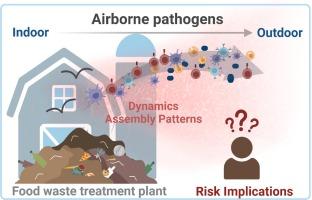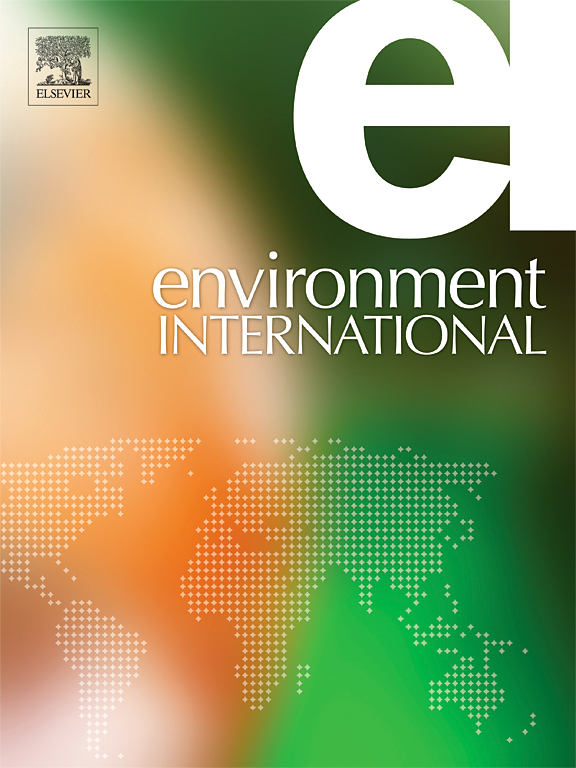The dynamics and assembly patterns of airborne pathogen communities in the municipal food waste treatment system and its risk implications
IF 10.3
1区 环境科学与生态学
Q1 ENVIRONMENTAL SCIENCES
引用次数: 0
Abstract
While municipal solid waste (MSW) provides an ideal habitat for pathogen propagation, the dynamics and assembly of airborne pathogen communities in these environments remain largely unknown. Here, we combined amplicon and metagenomics with spatiotemporal sampling to study inhalable particulate matter-carried potential pathogenic bacteria at full-scale food waste treatment plants (FWTPs), alongside comparisons to urban air in the area. The results showed that pathogenic bacteria constituted a notable portion (64.5 % ± 20.6 %, n = 75) of the total bacterial communities in FWTPs-impacted air, with species and relative abundance 2–4 times higher than that of urban air, and contributed over 50 % of pathogens to the outdoor air. Airborne pathogen community structures were highly shaped by sampling sites (i.e. treatment units), but conserved across seasons (summer vs. winter) and particle sizes (PM2.5 vs. PM10). Notably, Acinetobacter johnsonii-dominated pathogens (i.e. biofilm-related species) presented high levels of aerosolization and consistently occupied the upper-representative niches in all neutral models, highlighting their persistent exposure risk. Furthermore, pathogen community assembly was strongly driven by stochastic processes (58.8 %–96.8 %), while environmental variables explained only limited variations (3.4 %–28.7 %). In particular, the relative importance of stochastic processes clearly increased along an outdoor-to-indoor gradient (84.9 %–96.5 % vs. 71.3 %–76 %), which might be related to indoor anthropogenic activities that weaken microbial network stability and environmental filtering effects. This work enhances our knowledge of the dynamic behaviors and risk of airborne pathogen communities in MSW disposal and underscores the role of FWTPs in disseminating airborne pathogens.


城市厨余处理系统中空气传播病原体群落的动态和集结模式及其风险影响
虽然城市固体废物(MSW)为病原体的传播提供了一个理想的栖息地,但这些环境中空气传播病原体群落的动态和组合在很大程度上仍不为人所知。在这里,我们将扩增子和元基因组学与时空取样相结合,研究了全规模食物垃圾处理厂(FWTPs)中可吸入颗粒物携带的潜在病原菌,并与该地区的城市空气进行了比较。结果表明,在受食物垃圾处理厂影响的空气中,病原菌占细菌群落总数的很大一部分(64.5 % ± 20.6 %,n = 75),其种类和相对丰度是城市空气的 2-4 倍,并且在室外空气中占病原体的 50%以上。空气中的病原体群落结构在很大程度上受采样地点(即处理单位)的影响,但在不同季节(夏季与冬季)和颗粒大小(PM2.5 与 PM10)之间保持一致。值得注意的是,以约翰逊杆菌(Acinetobacter johnsoni)为主的病原体(即与生物膜相关的物种)的气溶胶化水平很高,在所有中性模型中始终占据上层代表壁龛,这突出表明了它们的持续暴露风险。此外,病原体群落的形成主要受随机过程的驱动(58.8%-96.8%),而环境变量只能解释有限的变化(3.4%-28.7%)。特别是,随机过程的相对重要性在从室外到室内的梯度上明显增加(84.9%-96.5% vs. 76%-71.3%),这可能与室内人为活动削弱了微生物网络的稳定性和环境过滤效应有关。这项研究增进了我们对都市固体废物处理过程中空气传播病原体群落的动态行为和风险的了解,并强调了垃圾填埋场在传播空气传播病原体方面的作用。
本文章由计算机程序翻译,如有差异,请以英文原文为准。
求助全文
约1分钟内获得全文
求助全文
来源期刊

Environment International
环境科学-环境科学
CiteScore
21.90
自引率
3.40%
发文量
734
审稿时长
2.8 months
期刊介绍:
Environmental Health publishes manuscripts focusing on critical aspects of environmental and occupational medicine, including studies in toxicology and epidemiology, to illuminate the human health implications of exposure to environmental hazards. The journal adopts an open-access model and practices open peer review.
It caters to scientists and practitioners across all environmental science domains, directly or indirectly impacting human health and well-being. With a commitment to enhancing the prevention of environmentally-related health risks, Environmental Health serves as a public health journal for the community and scientists engaged in matters of public health significance concerning the environment.
 求助内容:
求助内容: 应助结果提醒方式:
应助结果提醒方式:


